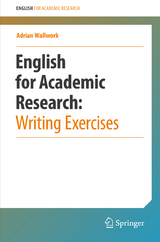English for Academic Research: Writing Exercises
Seiten
2012
Springer-Verlag New York Inc.
978-1-4614-4297-4 (ISBN)
Springer-Verlag New York Inc.
978-1-4614-4297-4 (ISBN)
- Titel erscheint in neuer Auflage
- Artikel merken
Zu diesem Artikel existiert eine Nachauflage
As with its sister publications, this volume of analysis and exercises gets to the heart of written English, providing would-be academicians with exercises that tackle the mistakes most often made by non-native writers, for example in paragraphing.
This book is based on a study of referees' reports and letters from journal editors on reasons why papers written by non-native researchers are rejected due to problems with English (long sentences, redundancy, poor structure etc). It draws on English-related errors from around 5000 papers written by non-native authors, around 3000 emails, 500 abstracts by PhD students, and over 1000 hours of teaching researchers how to write and present research papers.
The exercises are organized into ten chapters on:
punctuation and spelling
word order
writing short sentences and paragraphs
link words - connecting phrases and sentences together
being concise and removing redundancy
ambiguity and political correctness
paraphrasing and avoiding plagiarism
defining, comparing, evaluating and highlighting
anticipating possible objections, indicating level of certainty, discussion limitations, hedging, future work
writing each section of a paper
Some exercises require no actual writing but simply choosing between various options, thus facilitating self-study, e-reading and rapid progress. In those exercises where extended writing is required, model answers are given. Exercise types are repeated for different contexts, for example the importance of being concise is tested for use in papers, referees' reports, and emails of various types. Such repetition of similar types of exercises is design
ed to facilitate revision.
The exercises can also be integrated into English for Academic Purposes (EAP) and English for Special Purposes (ESP) courses at universities and research institutes.
The book can be used in conjunction with the other exercise books in the series and is cross-referenced to:
English for Research: Usage, Style, and Grammar
English for Writing Research Papers
This book is based on a study of referees' reports and letters from journal editors on reasons why papers written by non-native researchers are rejected due to problems with English (long sentences, redundancy, poor structure etc). It draws on English-related errors from around 5000 papers written by non-native authors, around 3000 emails, 500 abstracts by PhD students, and over 1000 hours of teaching researchers how to write and present research papers.
The exercises are organized into ten chapters on:
punctuation and spelling
word order
writing short sentences and paragraphs
link words - connecting phrases and sentences together
being concise and removing redundancy
ambiguity and political correctness
paraphrasing and avoiding plagiarism
defining, comparing, evaluating and highlighting
anticipating possible objections, indicating level of certainty, discussion limitations, hedging, future work
writing each section of a paper
Some exercises require no actual writing but simply choosing between various options, thus facilitating self-study, e-reading and rapid progress. In those exercises where extended writing is required, model answers are given. Exercise types are repeated for different contexts, for example the importance of being concise is tested for use in papers, referees' reports, and emails of various types. Such repetition of similar types of exercises is design
ed to facilitate revision.
The exercises can also be integrated into English for Academic Purposes (EAP) and English for Special Purposes (ESP) courses at universities and research institutes.
The book can be used in conjunction with the other exercise books in the series and is cross-referenced to:
English for Research: Usage, Style, and Grammar
English for Writing Research Papers
Adrian Wallwork is the author of around 30 ELT and EAP textbooks. He has trained several thousand PhD students from 35 countries to write and present academic work.
1. Punctuation and Spelling.- 2. Word Order.- 3. Writing Short Sentences and Paragraphs.- 4. Link Words: Connecting Phrases and Sentences Together.- 5. Being Concise and Removing Redundancy.- 6. Ambiguity and Political Correctness.- 7. Paraphrasing and Avoiding Plagiarism.- 8. Defining, Comparing, Evaluating, and Highlighting.- 9. Anticipating Possible Objections, Indicating Level of Certainty, Discussing Limitations, Hedging, Future Work.- 10. Writing Each Section of a Paper.- Acknowledgements.- About the Author.- Editing Service.- Index.
| Erscheint lt. Verlag | 14.12.2015 |
|---|---|
| Reihe/Serie | English for Academic Research |
| Zusatzinfo | XV, 190 p. |
| Verlagsort | New York, NY |
| Sprache | englisch |
| Maße | 155 x 235 mm |
| Themenwelt | Schulbuch / Wörterbuch ► Wörterbuch / Fremdsprachen |
| Geisteswissenschaften ► Sprach- / Literaturwissenschaft ► Sprachwissenschaft | |
| Medizin / Pharmazie | |
| Sozialwissenschaften ► Kommunikation / Medien ► Kommunikationswissenschaft | |
| Sozialwissenschaften ► Kommunikation / Medien ► Medienwissenschaft | |
| Sozialwissenschaften ► Pädagogik ► Allgemeines / Lexika | |
| Sozialwissenschaften ► Pädagogik ► Schulpädagogik / Grundschule | |
| Schlagworte | Englischunterricht • English as Second Language • Writing • Writing Exercises |
| ISBN-10 | 1-4614-4297-4 / 1461442974 |
| ISBN-13 | 978-1-4614-4297-4 / 9781461442974 |
| Zustand | Neuware |
| Informationen gemäß Produktsicherheitsverordnung (GPSR) | |
| Haben Sie eine Frage zum Produkt? |
Mehr entdecken
aus dem Bereich
aus dem Bereich
Das umfassende Standardwerk auf der Grundlage der aktuellen amtlichen …
Buch | Hardcover (2024)
Duden (Cornelsen Verlag)
CHF 48,95





